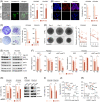Targeting G9a/DNMT1 methyltransferase activity impedes IGF2-mediated survival in hepatoblastoma
- PMID: 38285887
- PMCID: PMC10830081
- DOI: 10.1097/HC9.0000000000000378
Targeting G9a/DNMT1 methyltransferase activity impedes IGF2-mediated survival in hepatoblastoma
Abstract
Background: As the variable clinical outcome of patients with hepatoblastoma (HB) cannot be explained by genetics alone, the identification of drugs with the potential to effectively reverse epigenetic alterations is a promising approach to overcome poor therapy response. The gene ubiquitin like with PHD and ring finger domains 1 (UHRF1) represents an encouraging epigenetic target due to its regulatory function in both DNA methylation and histone modifications and its clinical relevance in HB.
Methods: Patient-derived xenograft in vitro and in vivo models were used to study drug response. The mechanistic basis of CM-272 treatment was elucidated using RNA sequencing and western blot experiments.
Results: We validated in comprehensive data sets that UHRF1 is highly expressed in HB and associated with poor outcomes. The simultaneous pharmacological targeting of UHRF1-dependent DNA methylation and histone H3 methylation by the dual inhibitor CM-272 identified a selective impact on HB patient-derived xenograft cell viability while leaving healthy fibroblasts unaffected. RNA sequencing revealed downregulation of the IGF2-activated survival pathway as the main mode of action of CM-272 treatment, subsequently leading to loss of proliferation, hindered colony formation capability, reduced spheroid growth, decreased migration potential, and ultimately, induction of apoptosis in HB cells. Importantly, drug response depended on the level of IGF2 expression, and combination assays showed a strong synergistic effect of CM-272 with cisplatin. Preclinical testing of CM-272 in a transplanted patient-derived xenograft model proved its efficacy but also uncovered side effects presumably caused by its strong antitumor effect in IGF2-driven tumors.
Conclusions: The inhibition of UHRF1-associated epigenetic traces, such as IGF2-mediated survival, is an attractive approach to treat high-risk HB, especially when combined with the standard-of-care therapeutic cisplatin.
Copyright © 2024 The Author(s). Published by Wolters Kluwer Health, Inc. on behalf of the American Association for the Study of Liver Diseases.
Conflict of interest statement
The authors have no conflicts to report.
Figures






Similar articles
-
Targeting of the G9a, DNMT1 and UHRF1 epigenetic complex as an effective strategy against pancreatic ductal adenocarcinoma.J Exp Clin Cancer Res. 2025 Jan 15;44(1):13. doi: 10.1186/s13046-024-03268-5. J Exp Clin Cancer Res. 2025. PMID: 39810240 Free PMC article.
-
Dual Targeting of Histone Methyltransferase G9a and DNA-Methyltransferase 1 for the Treatment of Experimental Hepatocellular Carcinoma.Hepatology. 2019 Feb;69(2):587-603. doi: 10.1002/hep.30168. Epub 2019 Jan 4. Hepatology. 2019. PMID: 30014490
-
Dual Targeting of G9a and DNA Methyltransferase-1 for the Treatment of Experimental Cholangiocarcinoma.Hepatology. 2021 Jun;73(6):2380-2396. doi: 10.1002/hep.31642. Hepatology. 2021. PMID: 33222246
-
Thymoquinone Is a Multitarget Single Epidrug That Inhibits the UHRF1 Protein Complex.Genes (Basel). 2021 Apr 22;12(5):622. doi: 10.3390/genes12050622. Genes (Basel). 2021. PMID: 33922029 Free PMC article. Review.
-
[Role of UHRF1 in methylation regulation and angiogenesis].Zhonghua Yi Xue Yi Chuan Xue Za Zhi. 2020 Feb 10;37(2):200-204. doi: 10.3760/cma.j.issn.1003-9406.2020.02.025. Zhonghua Yi Xue Yi Chuan Xue Za Zhi. 2020. PMID: 32034755 Review. Chinese.
Cited by
-
Drug prioritization identifies panobinostat as a tailored treatment element for patients with metastatic hepatoblastoma.J Exp Clin Cancer Res. 2024 Nov 12;43(1):299. doi: 10.1186/s13046-024-03221-6. J Exp Clin Cancer Res. 2024. PMID: 39529166 Free PMC article.
-
G9a/DNMT1 co-targeting inhibits non-small cell lung cancer growth and reprograms tumor cells to respond to cancer-drugs through SCARA5 and AOX1.Cell Death Dis. 2024 Nov 2;15(11):787. doi: 10.1038/s41419-024-07156-w. Cell Death Dis. 2024. PMID: 39488528 Free PMC article.
-
Hepatoblastoma: From Molecular Mechanisms to Therapeutic Strategies.Curr Oncol. 2025 Mar 4;32(3):149. doi: 10.3390/curroncol32030149. Curr Oncol. 2025. PMID: 40136353 Free PMC article. Review.
-
Targeting HSP90 with Ganetespib to Induce CDK1 Degradation and Promote Cell Death in Hepatoblastoma.Cancers (Basel). 2025 Apr 16;17(8):1341. doi: 10.3390/cancers17081341. Cancers (Basel). 2025. PMID: 40282517 Free PMC article.
-
Characterization of an Activated Metabolic Transcriptional Program in Hepatoblastoma Tumor Cells Using scRNA-seq.Int J Mol Sci. 2024 Dec 4;25(23):13044. doi: 10.3390/ijms252313044. Int J Mol Sci. 2024. PMID: 39684755 Free PMC article.
References
-
- Weinberg AG, Finegold MJ. Primary hepatic tumors of childhood. Hum Pathol. 1983;14:512–37. - PubMed
-
- Giardiello FM, Offerhaus GJ, Krush AJ, Booker SV, Tersmette AC, Mulder JW, et al. . Risk of hepatoblastoma in familial adenomatous polyposis. J Pediatr. 1991;119:766–8. - PubMed
-
- Little MH, Thomson DB, Hayward NK, Smith PJ. Loss of alleles on the short arm of chromosome 11 in a hepatoblastoma from a child with Beckwith-Wiedemann syndrome. Hum Genet. 1988;79:186–9. - PubMed
-
- Koch A, Denkhaus D, Albrecht S, Leuschner I, von Schweinitz D, Pietsch T. Childhood hepatoblastomas frequently carry a mutated degradation targeting box of the beta-catenin gene. Cancer Res. 1999;59:269–73. - PubMed
-
- Eichenmüller M, Trippel F, Kreuder M, Beck A, Schwarzmayr T, Häberle B, et al. . The genomic landscape of hepatoblastoma and their progenies with HCC-like features. J Hepatol. 2014;61:1312–20. - PubMed
Publication types
MeSH terms
Substances
LinkOut - more resources
Full Text Sources
Medical
Research Materials
Miscellaneous

